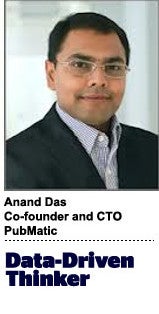 “Data-Driven Thinking” is written by members of the media community and contains fresh ideas on the digital revolution in media.
“Data-Driven Thinking” is written by members of the media community and contains fresh ideas on the digital revolution in media.
Today’s column is written by Anand Das, co-founder and chief technology officer at PubMatic.
It’s only October – way too early for end-of-year summaries – but one thing is already certain: 2013 marks the beginning of the end of the third-party cookie.
With Firefox overlooking ad industry criticism, and Google and Microsoft working toward anonymous identification solutions, it’s clear we’re moving into a new era of ad tech.
But what exactly will happen is far from clear. A closer look at the market offerings reveals a plethora of solutions, many of them imperfect. One company, for example, is developing a model to allow advertisers to register themselves, thus enabling them to opt out at a global level. The browser companies have acknowledged they are working on their own identification solutions.
Other companies are trying to generate a model that enables the creation of a noncookie browser identifier. That is a promising idea, and one that could potentially be of real value to publishers, advertisers and users as we start to look at consumers across devices.
This development, however, raises the obvious question of proper usage, or how the user might opt out of being tracked or receiving certain kinds of display content. In such a precarious landscape, third-party cookies are still a strong standard.
How do we address this problem as an industry? Sadly, there is no silver bullet or balm guaranteeing the collection and utilization of infallible user ID while simultaneously adhering to the most rigid privacy protection standards. As we welcome a host of good but ultimately flawed technical solutions, we should make sure that we focus on those who often get lost in the discussion. I’m not talking about the advertisers or the end users, but rather the publishers.
With third-party cookies, even good advertising is a lost opportunity for publishers because they are not in control of delivering the cookie to the user. If we put publishers in control of what happens to the data they collect – namely, who gets to know what about users on their website – we would allow them to determine how big the demand is from the advertisers, which, in turn, would allow them to use the data to target users more effectively.
To support the needs of publishers, advertisers and users alike, we need to think less of individual relationships and more about communal ones. Publishers need to be more in sync with each other.
This can be achieved in various ways. They could, for example, share user IDs collected with other partner publishers, so that even publishers who do not have the mechanism to identify users could target users based on data collected elsewhere. If the ID methodologies become fairly open and standard, they could prevent privacy infringement. This approach would allow any user to opt out of an ad at any given moment within a given network of publishers.
AdExchanger Daily
Get our editors’ roundup delivered to your inbox every weekday.
Daily Roundup
Approaches to the same problems may vary, but successful solutions will reflect the fact that despite the technological buzz and algorithmic progress, the core of the business remains unchanged. It’s a three-way relationship between those who publish content, those who consume it and those who wish to advertise it.
All we have to do is ensure this relationship is as smooth as possible. We have better tools than third-party cookies to do just that.
Follow Anand Das (@ananddas), PubMatic (@PubMatic) and AdExchanger (@adexchanger) on Twitter.













